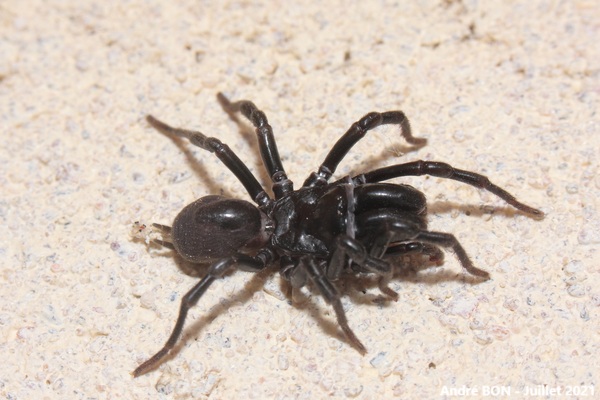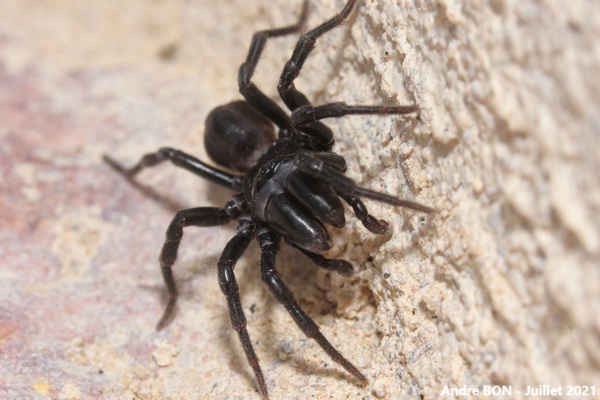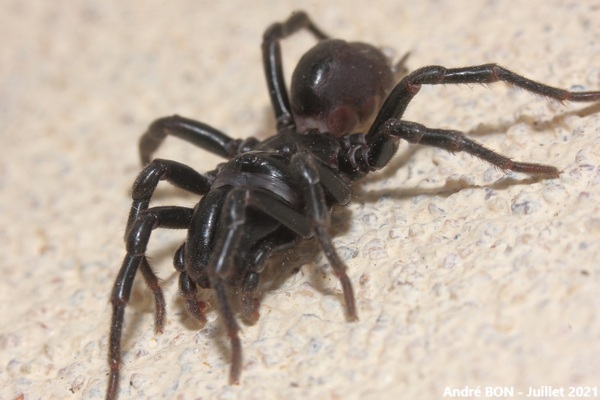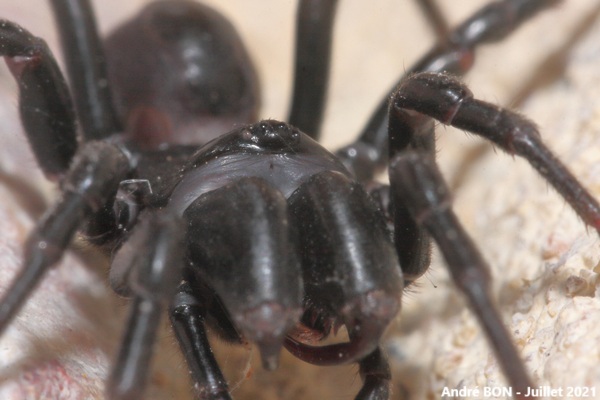



| Atypus sp. (Latreille, 1804) |




|
|
Scientific name: Atypus sp. (Latreille, 1804) Common name: French name: Order: Araneae Family: Atypidae Size: Medium to large. If we restrict ourselves to European species, the Purse-web Spider (Atypus affinis), Atypus piceus and Atypus muralis: 7 to 9 mm for males and 10 to 15 mm for females (body size without chelicerae). Biotope: Sunny, sandy or limestone environments, dry lawns, moors, embankments, pine forests, deciduous forests. Web: These spiders dig a burrow several tens of centimeters long. It is lined with silk and is extended at its exit by a silk tube of around ten centimeters placed on the ground. The spider detects preys passing over this tube and captures them through the silk. Observation period: These spiders can live for several years up to 8 to 10 years. Females are difficult to observe because they remain in their burrows. The specimens observed are often males wandering during the breeding season. The young spend the winter in the burrow with their mother then all climb on the same plant in the first fine days where they weave silk threads until they are carried away by the wind. Geographic area: Spiders of the Atypus genus are found in Europe, Asia, North Africa and North America. The Purse-web Spider (Atypus affinis) is found in Europe north to southern Sweden, and in North Africa. Atypus piceus is found in Europe east to western Russia, Iran, missing in the Iberian Peninsula, the British Isles, the Baltic Countries and Scandinavia. Atypus muralis is found in Central Europe west to eastern Switzerland and east to Turkmenistan in Central Asia. |
Spiders of the Atypus genus are mygalomorph spiders characterized by large chelicerae and their fangs arranged straight along the axis of the body. The 8 eyes are grouped together on a small prominence on the front of the head. Males have a smaller and narrower abdomen than females. It has a scutum (sclerotized and shiny plate) on the front of the dorsal surface. The most reliable method for identifying the three European species is to examine the spinnerets (bottom view required). The spinnerets of the Purse-web Spider (Atypus affinis) are made up of three articles of approximately equal length. The spinnerets of Atypus piceus are made up of three articles of unequal length. The last article is much longer than the previous one. It is marked with a clear half ring on the underside. Be careful in dorsal view, this last article shows a sort of pseudo segmentation which could lead to wrongly counting four articles. The spinnerets of Atypus muralis are made up of four articles. These tarantulas are not dangerous to humans. Due to their way of life in a burrow, it is very rare to encounter them other than a wandering male during the breeding season. They are never aggressive but can still bite/sting if handled and the reaction is roughly equivalent to that of a wasp sting. |
| [To know more about the Atypus sp.] [Next picture] [Top] |

|
What a pleasure to find this beautiful spider right outside the front door of the house. It is a male as confirmed by the shiny black scutum on the front of the abdomen. It is therefore either the Purse-web Spider (Atypus affinis) or Atypus piceus. What we see of the spinnerets on the back of the abdomen is not enough to determine the species. |
| [To know more about the Atypus sp.] [Next picture] [Previous picture] [Top] |

|
I'll have to start looking for silk tubes in the area. I read that they are difficult to detect because they are often covered with dust and various debris. |
| [To know more about the Atypus sp.] [Next picture] [Previous picture] [Top] |

|
If one day I have the chance to come across a specimen again, I will try to photograph the ventral side. |
| [To know more about the Atypus sp.] [Previous picture] [Top] |

|
Close-up showing the eight eyes grouped together on a small prominence on the front of the head. We can guess fairly large teeth under the chelicerae. A precise view of the arrangement and more or less regular size of these teeth could also have given an indication about the species. |